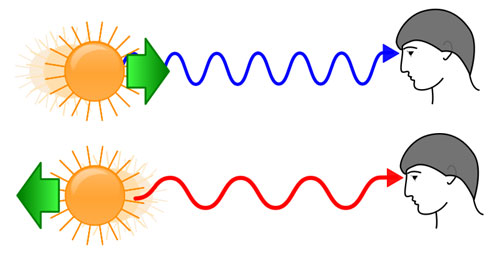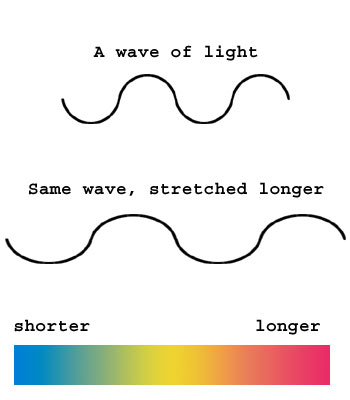The Reality of Redshift
Posted Sep 03, 2010The redshift discovered and observed in physical cosmology is an interesting phenomenon. The interpretation of it doubly so.
But what if the conclusions drawn are incorrect, due to the redshift being an optical illusion brought upon by an incorrect assumption?
In short, what if the scientists are wrong?
First, let's make sure we're all on the same, um, wavelength, if you will pardon the pun.
I prefer not using other people's images, but this one is just too well done, and explains this perfectly.
As something moves away from us, the wavelength (sound waves, electromagnetic radiation, light, etc.) appears to stretch out a bit. Since longer wavelengths in the visible spectrum heads toward the red end of the color spectrum, it appears to get more red.
That's the simple explanation. It can be more detailed, but you get the idea.
So, when this redshift was observed in stellar observation, the natural conclusion is that those items are moving farther away from us.
But then, scientists noticed that this redshift became more pronounced the farther away from Earth they viewed.
Well, of course this obviously means that the farther away the stellar material is, the faster it is moving away from us.
In all directions.
At a semi-uniformly increasing speed.
Meaning that all material in the universe is moving away from the earth (and each other) all at a similar speed.
Meaning something must be filling the void between matter in order to cause this movement.
Meaning....
Wait, wait wait!!!
Let's recheck some assumptions to make sure we aren't placing ourselves on a long, weak limb.
What is redshift?
It is the observation that electromagnetic radiation such as those in the visible spectrum we call light (more specifically photons) show signs of a longer wavelength than expected had the object causing the wavelength not been moving away from our position.
Longer wavelength than expected?
Why do we expect a certain length of wave?
Well, because we're talking about photons, meaning light. Light, as everyone who's ever heard of Einstein knows, is constant in speed and lifespan.
Um, wait. Is that right?
I mean light having a consistent speed is very well known an accepted, thanks largely due to Albert Einstein. (Although I disagree, but we'll touch on that later) However, I've never read about anything that says a photon has a lifecycle.
In fact, when researching photons and light, it seems that the photon is assumed to exist in the exact same form forever, until colliding with something. (hopefully our eye, thus allowing us to see.)
But is that really true?
The observable universe is said to be (currently) about 13-14 billion years old.
Imagine this for a moment:
A single photon launched from the flame of a star, heading out into space in our direction.
A year goes by. (It travels almost 6 trillion miles in this time)
100 years goes by. Still it approaches.
1,000,000 years. (traveling longer than the human species ever existed) Luckily, it hasn't hit anything along the way.
1 billion years.
5 billion years.
10 billion years.
And absolutely nothing has changed about this single photon at all?
Nothing?
There is a saying: The only constant is change. (Heraclitus, it seems, said this first, or at least, is written to have said it first.)
Now, it may be true that the photons sent from your monitor vs. the ones sent from the sun bear zero discernible differences in terms of "age". However, this may well be similar to viewing/measuring the difference in an white cedar tree seed when only 1 minute has passed. Changes may have occurred, but they are too small to detect within this short time frame. We're talking a time scale that extends far beyond our comprehension.
Ok, so, if a photon had a "life span", how might we prove this? As we've just admitted, we can detect photons created and heading toward us billions of years ago. So "immensely long life span" seems an understatement, and obviously something much too long for a single human (or even the entire human race) to observe on their own.
But, if we could observe old age in photons, what might it look like? What properties might we observe? Old age can be signified by a reduction of activity.
But what might a reduction of activity mean to a photon? Well, we do know one activity associated with them.
In short:
The redshift observed may actually be evidence that photons, while lasting an immensely long time, if left untouched, actually do have an eventual finite life span, and that a factor of this life span is a gradual reduction in the activity, meaning the increase in the wavelength.
If it's true that given long enough, these observable wavelengths might even slow down enough to pass out of the visible spectrum and move into what we classify as infrared, microwave, or even as far as radio waves.
In fact, the formulas used (I.E. Hubble's law) for this redshift, might actually be better used to describe and predict the multi-trillion years long lifespan of photons.
This by the way, may also help better explain the cosmic background microwave radiation observed. (Also keep in mind the connection with wavelength and temperature.)
The concept of a wavelength eventually losing energy and slowing down and getting longer is not a large stretch of the imagination. However, when it's applied to the most famous of waves, the implications change quite a bit about what is currently believed in cosmology today.